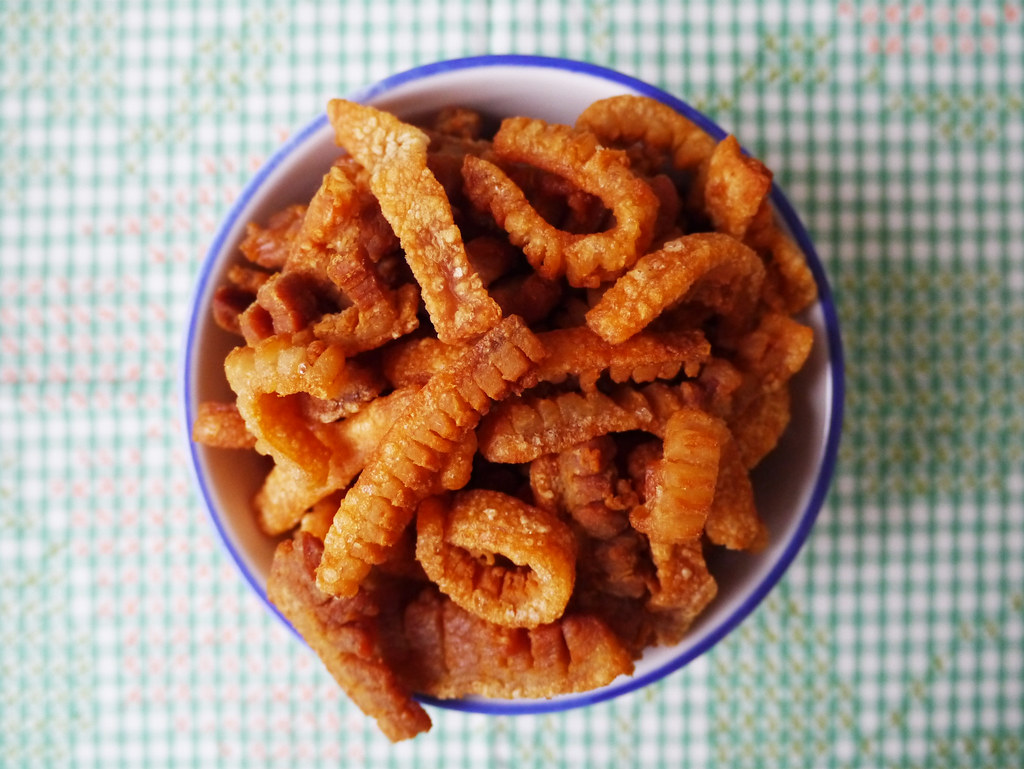
Delicious, grub-like morsels of pork crackling. They’re more addictive than crisps and Pringles!
Note: Before scrolling down, please be warned that this post contains demonstrative photos of pork meat being prepared. If you think you might find this offensive, please read a different post, perhaps How to make garlic, ginger and shallot oil?
~
[dropcap]Unless[/dropcap] you don’t eat pork (for whatever reason that may be [in which case, I am sorry – this post is not really for you {but you might still enjoy it and perhaps even convert – so please read on}]) – you’d have to agree that there’s really nothing more delicious to snack on than crispy and crunchy moreish this-is-not-too-good-for-me-i-know-but-just-one-more-piece-won’t-hurt fatty morsels of pork crackling/pork rind (fried or roasted – take your pick), famed across the world and known among its many fans as either pork scratching, chicharon, scrunchions, gratton, kiep moo, etc. 1
Pork crackling/pork rind, in all of its incarnations is a popular meat treat worldwide where it’s often served as a snack or accompaniment to a dish or meal, or added to recipes. It is often a byproduct when pork fat is rendered to make lard – that glorious traditional fat with the incomparable taste and multiple uses. This is why this recipe is so special – because, when frying/rendering pork fat and skin, you end up with both the crunchy crackling treats and also the divine unctuous lard that you can add to recipes and/or fry with. 2
In Lao cuisine, pork crackling is called “kiep moo” and lard is called “narm mun moo” and not surprisingly, kiep moo is a popular accompaniment to have with many dishes including tum mark hoong and “mieng” (Lao ground rice paste wraps), or to simply snack on in front of the tv, like I do. It can also be used to make “jeow kiep moo” – a variation of the ubiquitous Lao jeow (relish/sauce), which is a combination of pounded pork crackling with grilled herbs and spices. Narm mun moo, when available is a favoured choice over normal cooking oil when stir-frying.
The method of making pork crackling and lard is very simple, requiring only some prep time of chopping and slicing the pork pieces with a sharp knife/scissors and then gently frying and stirring them until the fat is rendered and the pork pieces turn crunchy and delicious. You can also roast the pork pieces instead – however, I find that the frying method is easier and I also have more control over the process. Depending on what cut of pork you’re using, and how much pork fat you’re frying, by adding a little cooking oil to the pan/wok before adding the pork pieces – this helps the pork to fry/render without burning or sticking to the surface.
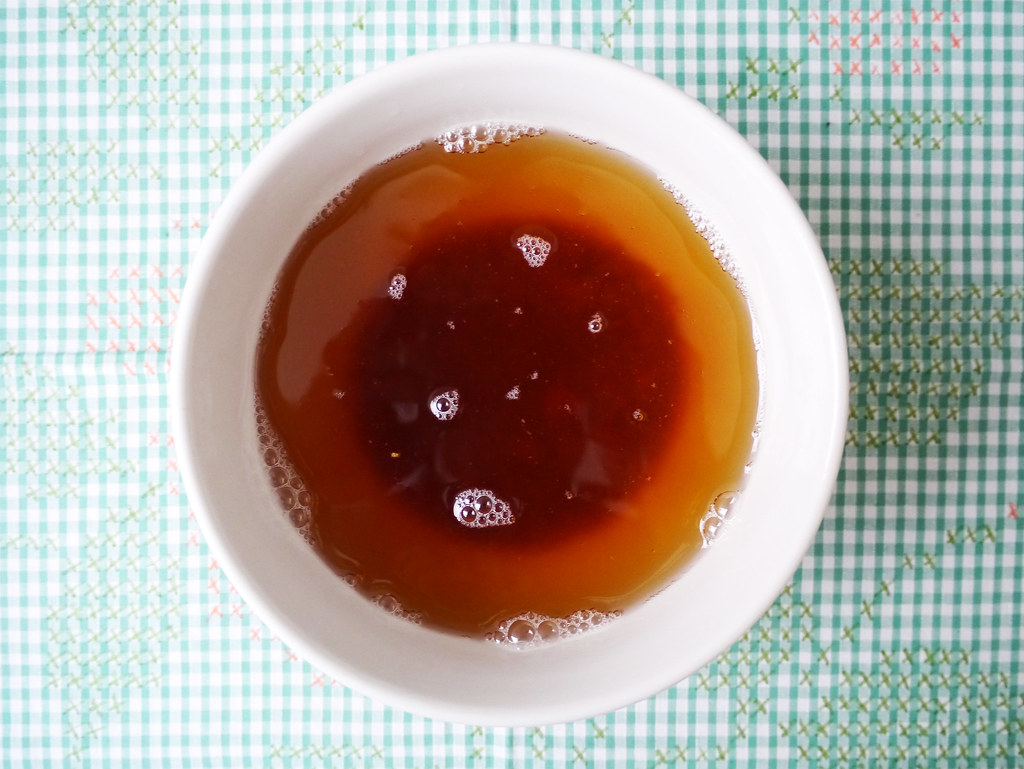
Glorious pork lard – freshly rendered.
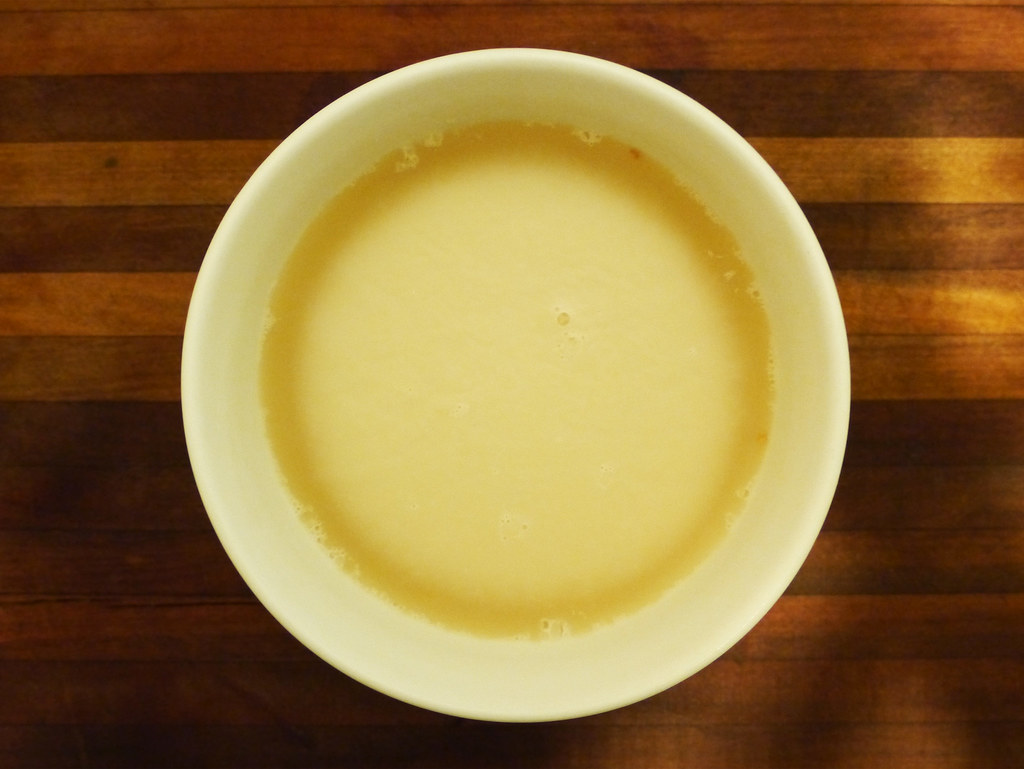
Pork lard – 3 hours later (after placed in the fridge).
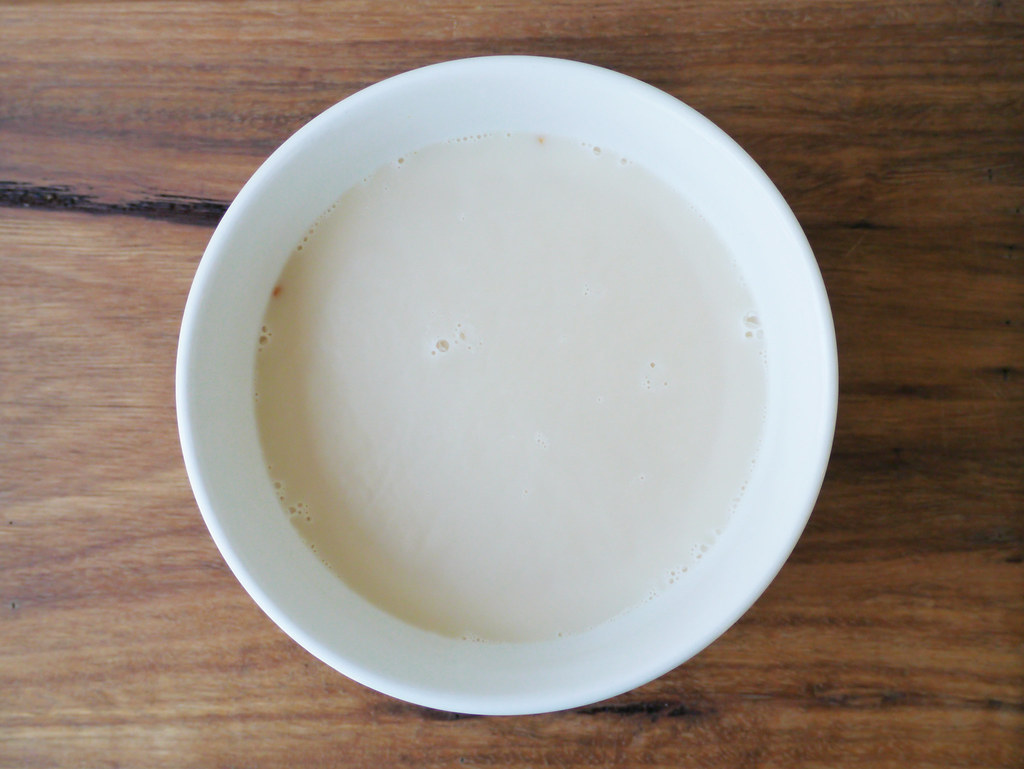
Pork lard – 24 hours later.
For me, the ideal ‘cut of pork’ to use to make both pork crackling and lard is pork belly because it has both the pork skin and a good layer of pork fat and pork meat. Alternatively, depending on what you want to make more of (pork crackling or lard), you can also use just pork rind/skin (which sometimes has some fat on it), or pork ‘leaf lard’ or pork ‘fatback’ which has more fat and are choice cuts to render lard with. 3
Pork spare ribs is another good option which is similar to pork belly. These cuts can sometimes be found at your local supermarket, otherwise, simply order them from your friendly butcher. If you decide to use the pork belly or pork spare ribs, cut off/remove the layer of meat from the skin and fat first, so that you can cut/score the underside of the skin/fat, which helps the fat render/cook faster and more evenly. 4
Pork crackling is a delicious snack food but also very addictive so be sure to restrain yourself when eating them. Everything in moderation, right? It’s obvious that pork crackling will not win the healthiest snack food of the year award, but I simply love them and that’s the reason why I’m sharing this recipe with you, and it’s a bonus that you can render and use the pork lard in your recipes as well. If you eat pork, then it’s most likely that you’ve experienced the joy of eating pork crackling before and know how good it tastes and can appreciate this recipe.
My pescetarian partner shivers when he sees me making and eating these, but once in a while it’s nice to treat myself to some. Our dog loves them also, so I don’t feel completely guilty making them. I hope you give this recipe a try and enjoy both the pork crackling and lard. You can make a small amount or a lot and serve as much as you want when needed and keep the rest locked in the fridge for later. Bon appetit and sern sap!
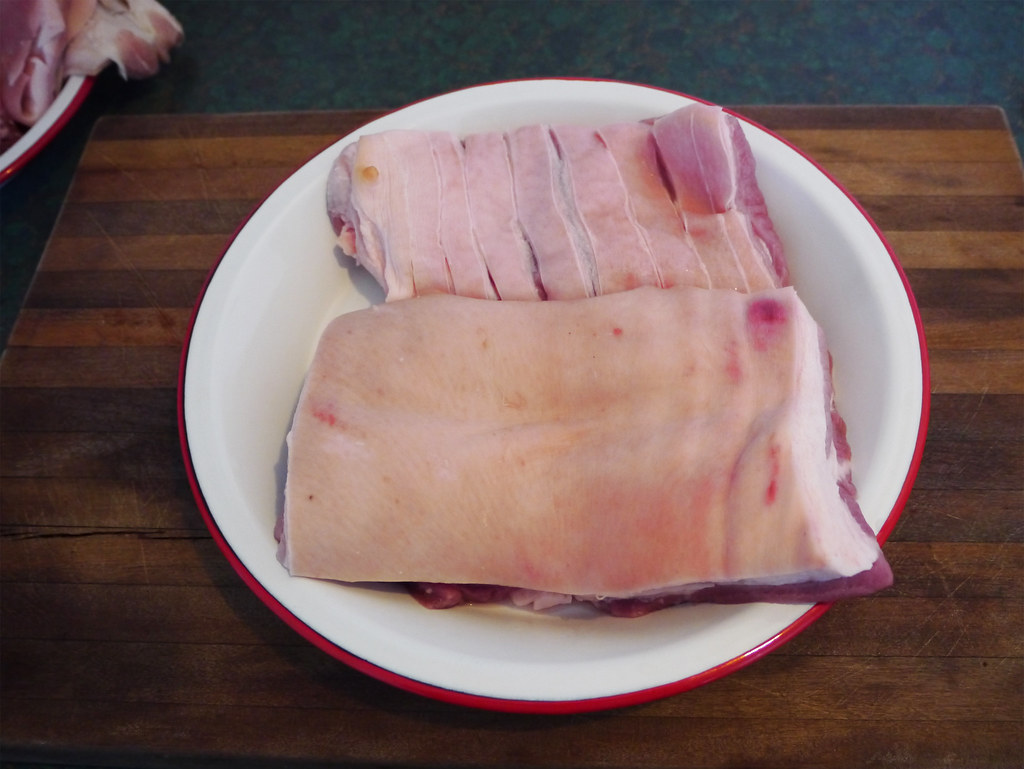
Pork belly.
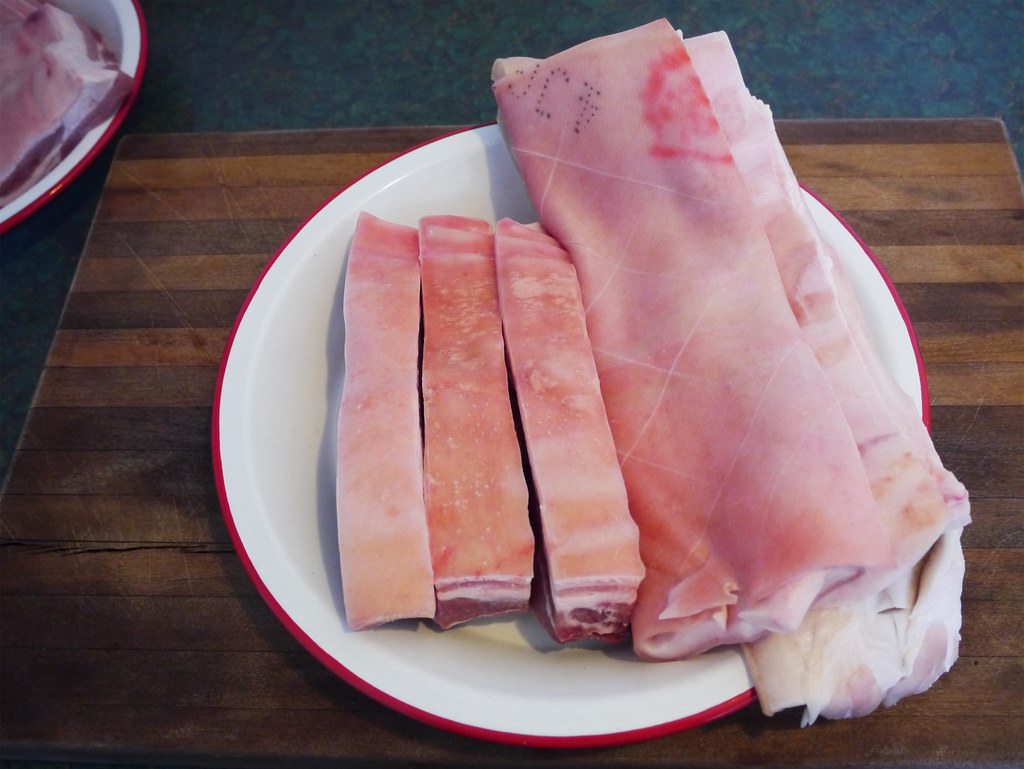
Pork spare ribs and pork rind/skin.

With a sharp knife, cut the underside of the pork rind with long straight lines. Don’t cut all the way through.
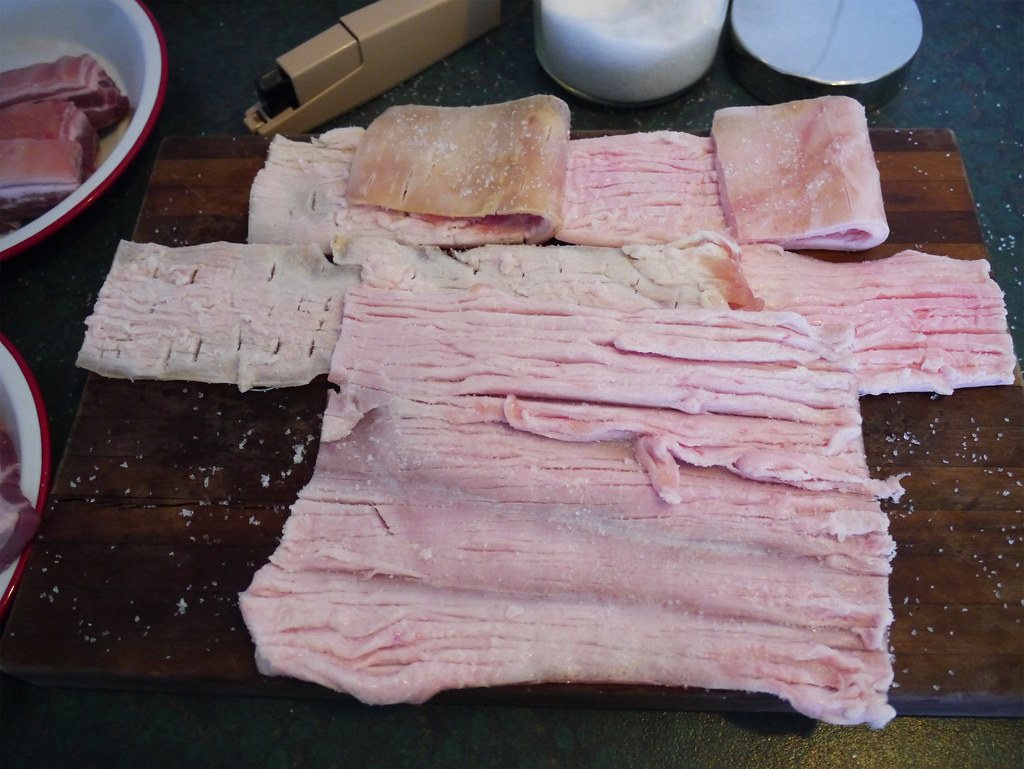
Lightly sprinkle some salt to both sides of the pork rind and rub all over. Note: If you want your pork crackling and lard to remain saltless, you can skip this step.
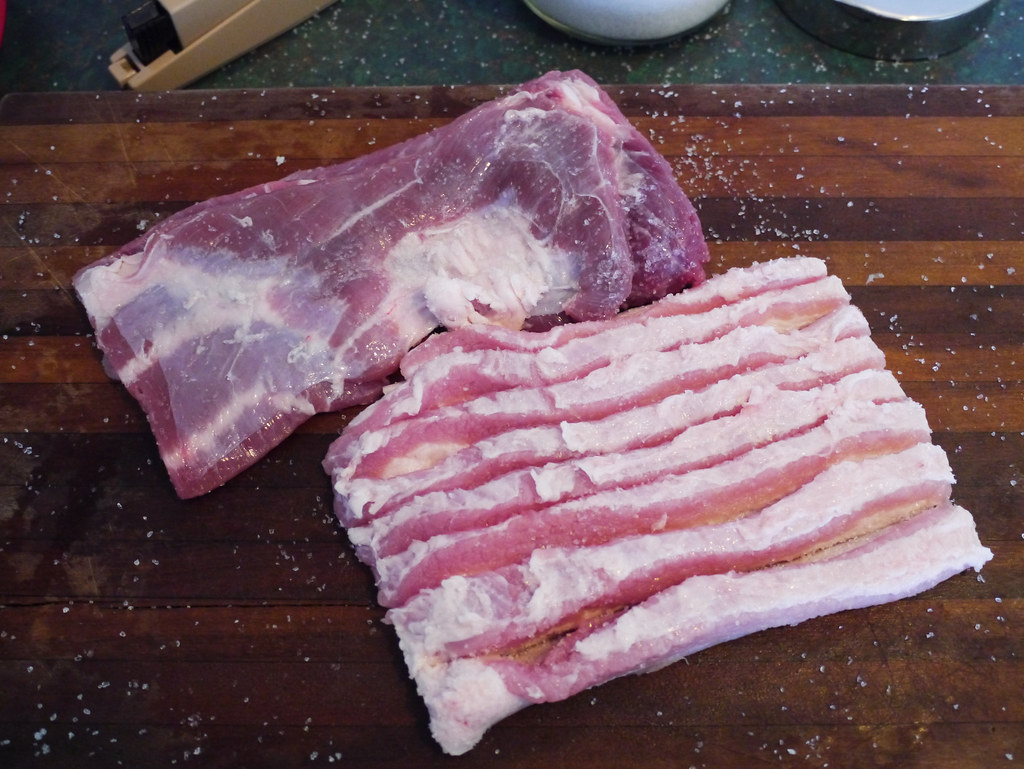
If you’re using pork belly or pork spare ribs, remove the layer of meat from underneath the pork skin first, before cutting the underside of the skin/fat with a knife.
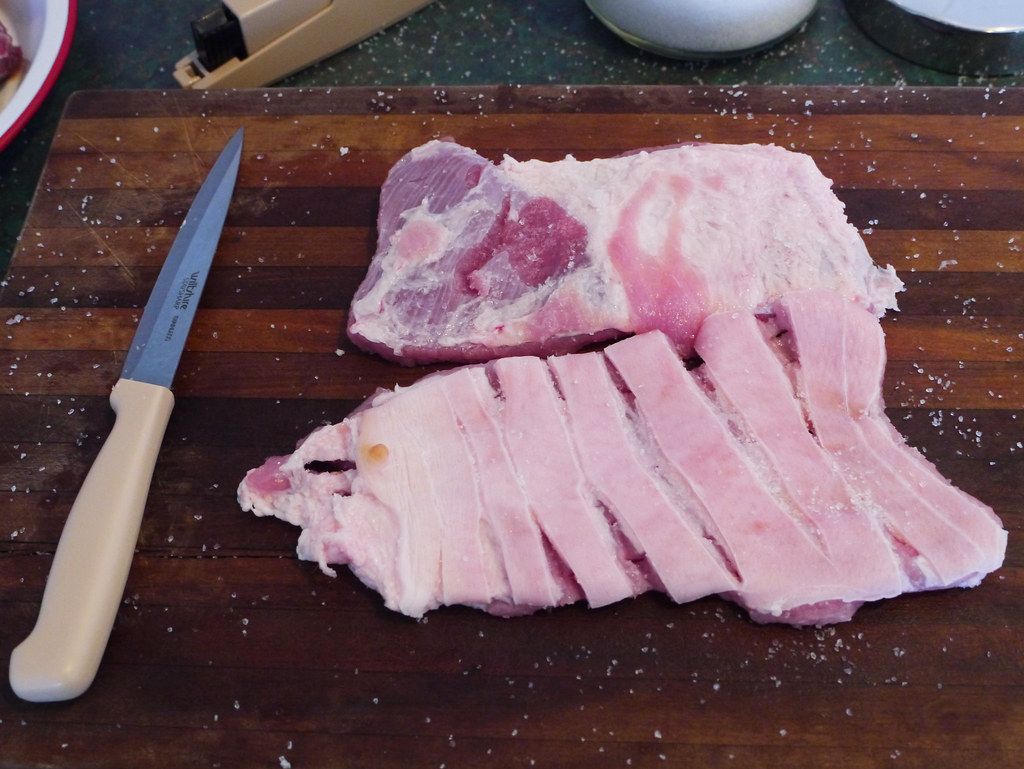
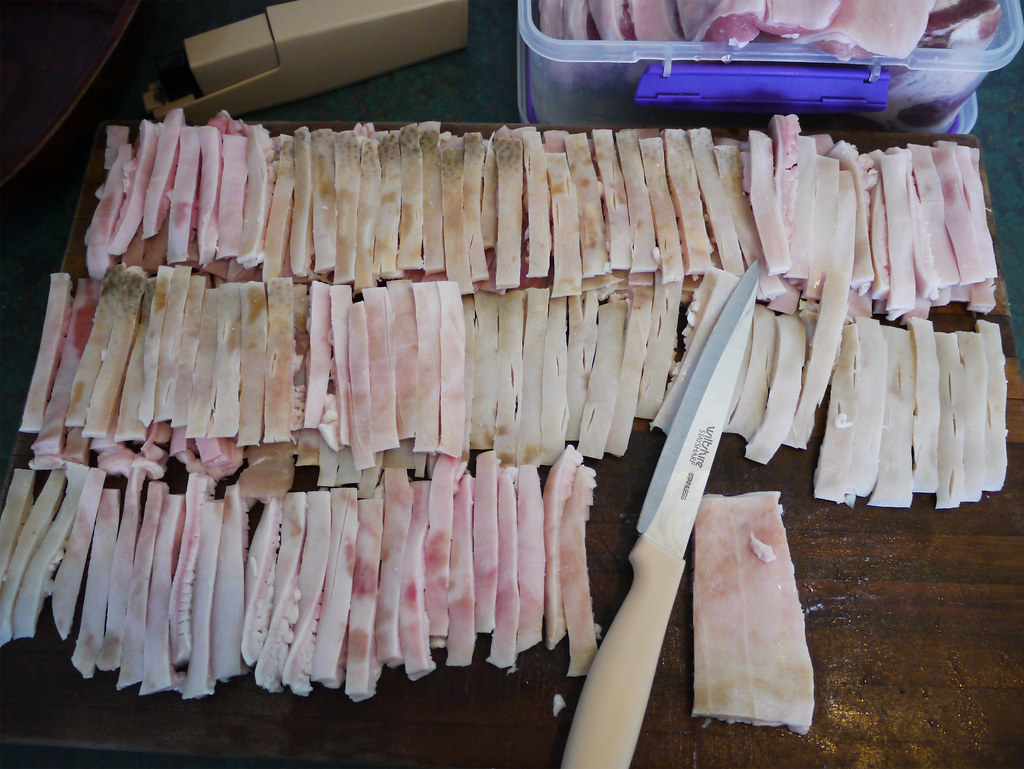
With a sharp knife or kitchen scissors, cut the pork skin into small pieces/strips. Remember that once cooked, the pork skin/crackling will shrink in size and also possibly curl up if it is a long strip. I like to cut them into about 1 cm x 5 cm pieces, but it’s really up to you how big and what shape you want your pork crackling to be. Note: I can’t speak highly enough about these self-sharpening knives. This one was given to me as a gift and it is incredibly sharp and although it looses some if its sharpness from time to time, especially from cutting the pork skin, by simply re-sharpening it in its case, it returns to its prime performance. I recommend them for this job, and please be extra careful when using them.
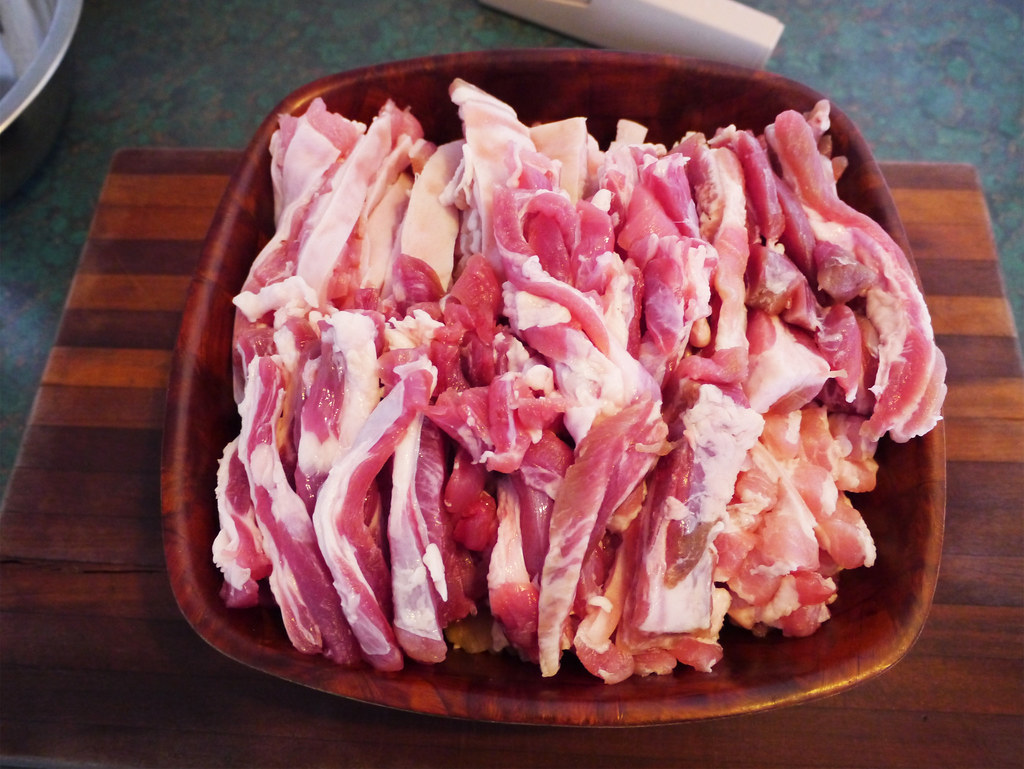
If you’re using pork belly or pork spare ribs, cut the fat and meat into small pieces as well. They also make delicious crunchy treats once cooked. Or, you can reserve them for another recipe.

In a saucepan or wok, add the cooking oil and bring to low-medium heat.
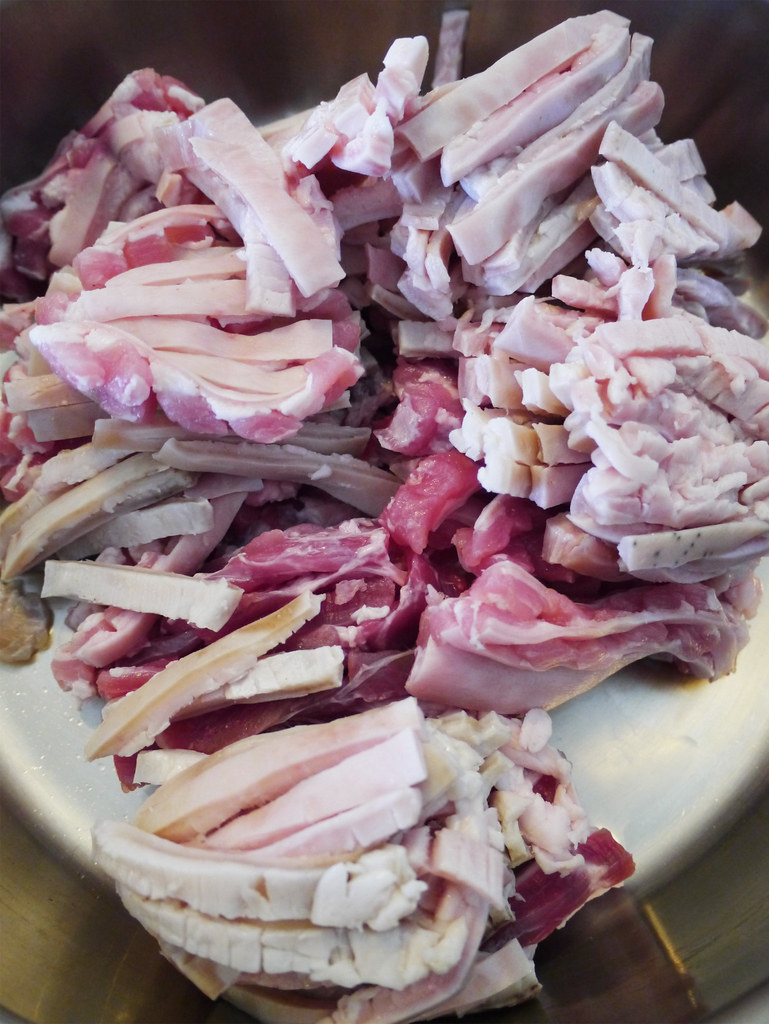
Add the sliced pork skin, fat and meat pieces and gently stir together.
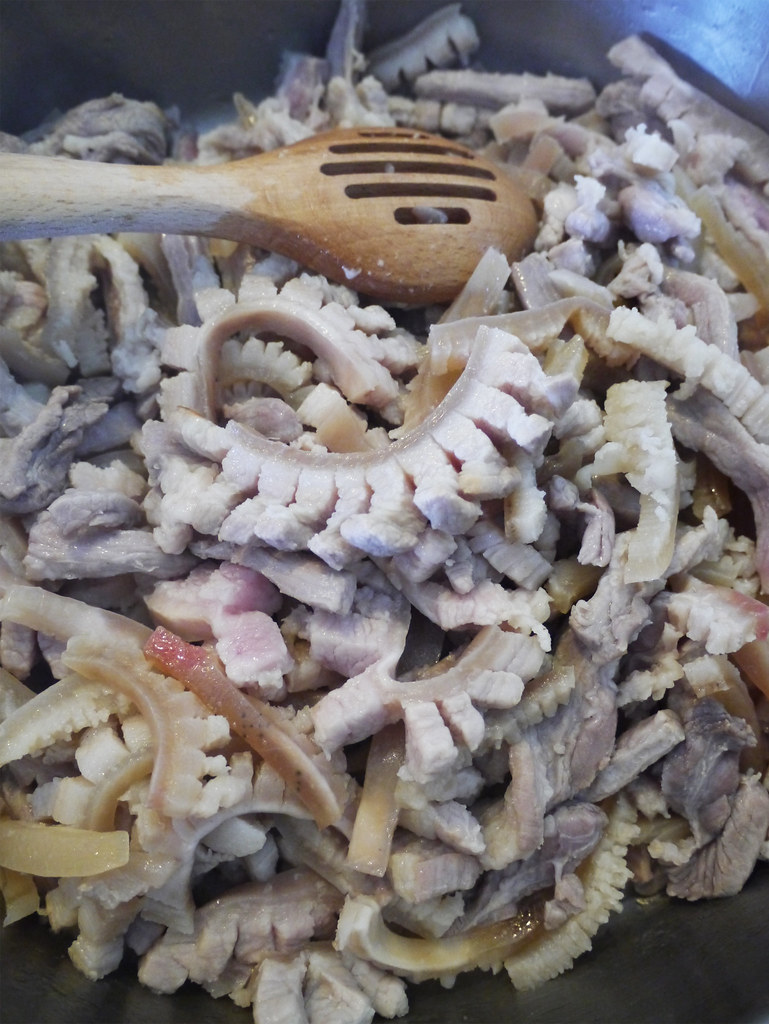
Continue to cook/fry the pork pieces and regularly stir.
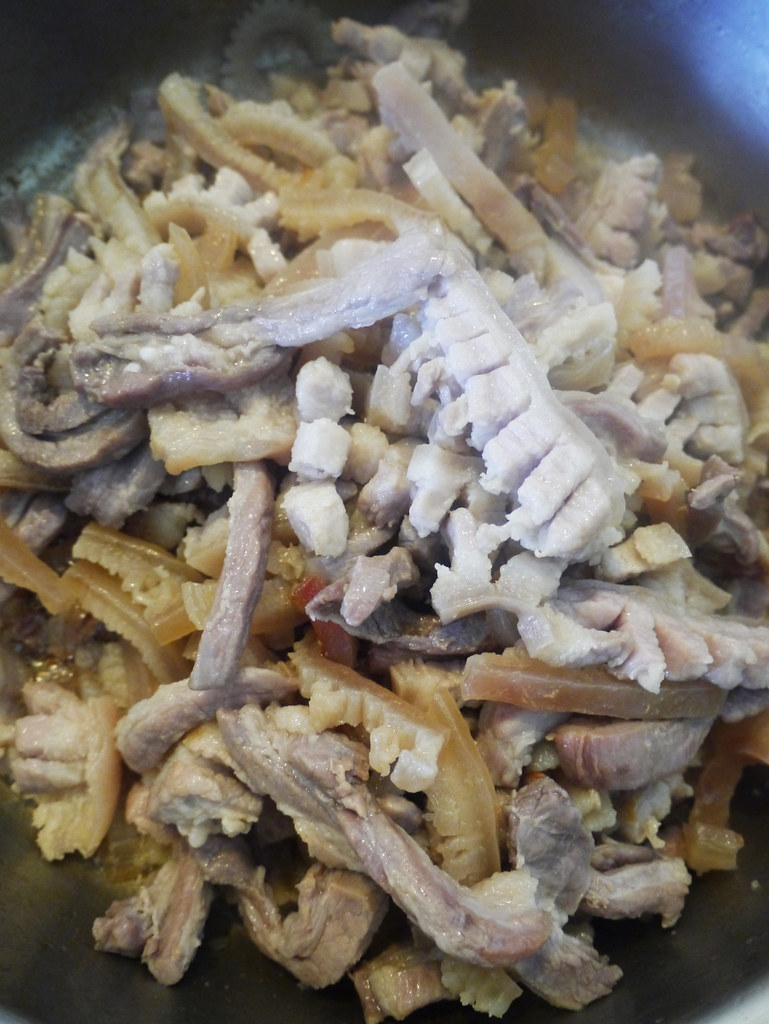
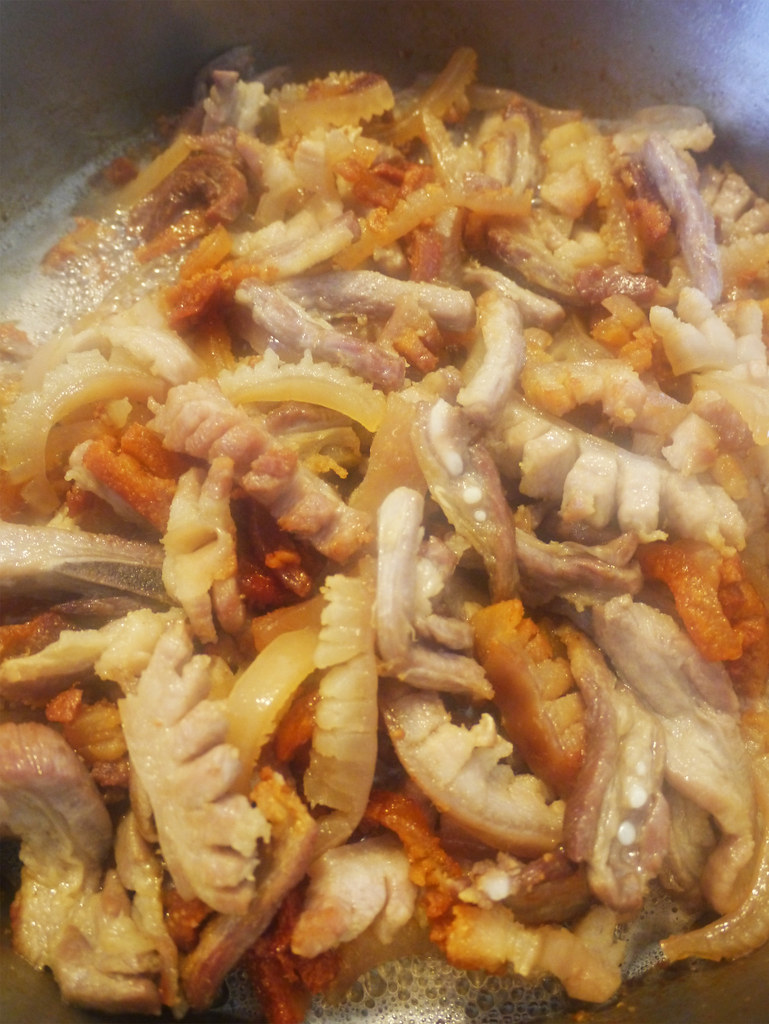
Be extra careful of the hot oil when stirring because it can pop and spit at you.
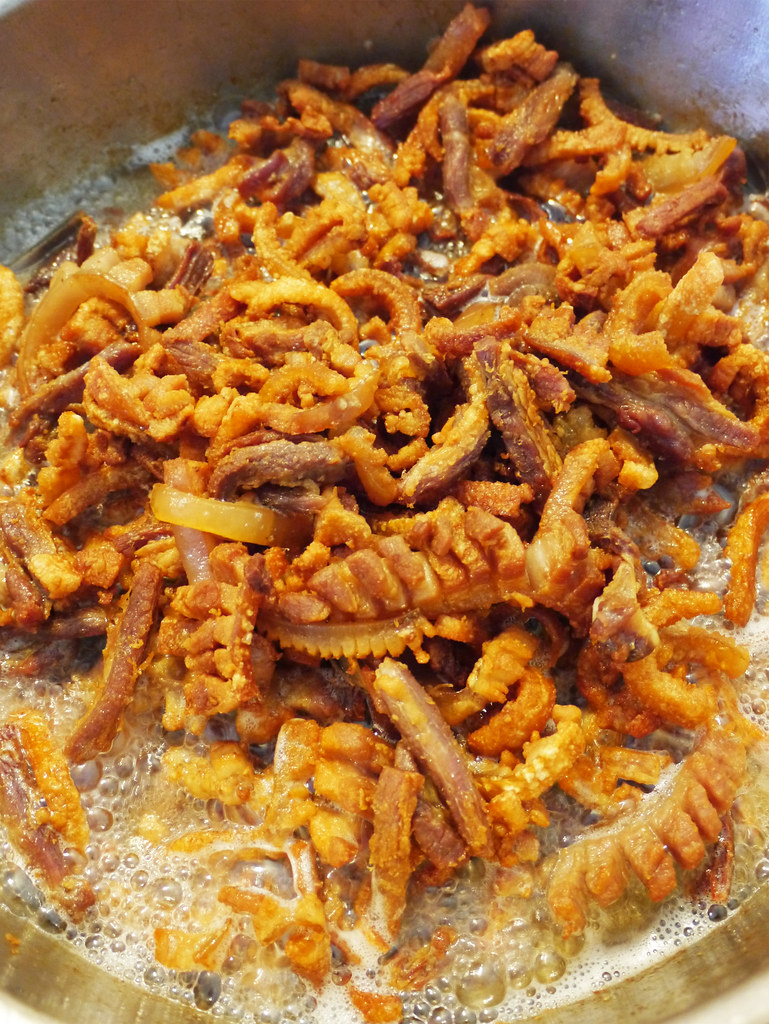
When the pork pieces turn to a light brown colour, you can increase the heat to medium. This will cause the pork skin to blister and become more crunchy and crackly. Be careful to not overcook, and the oil will also get hotter and possibly pop and spit even more.
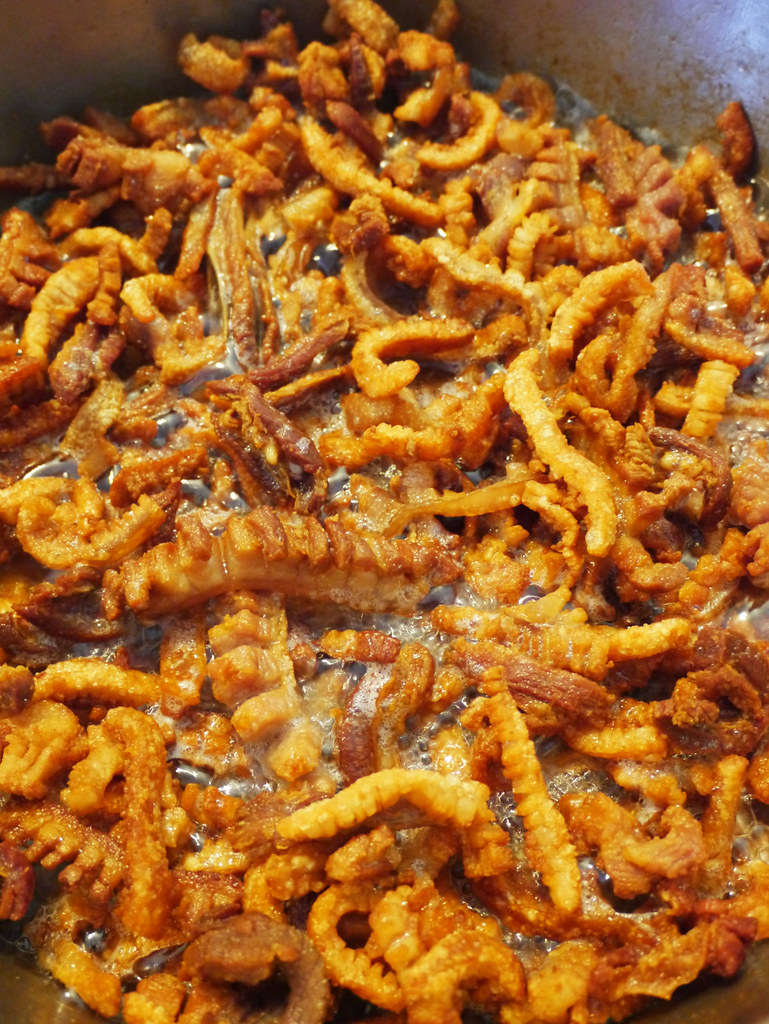
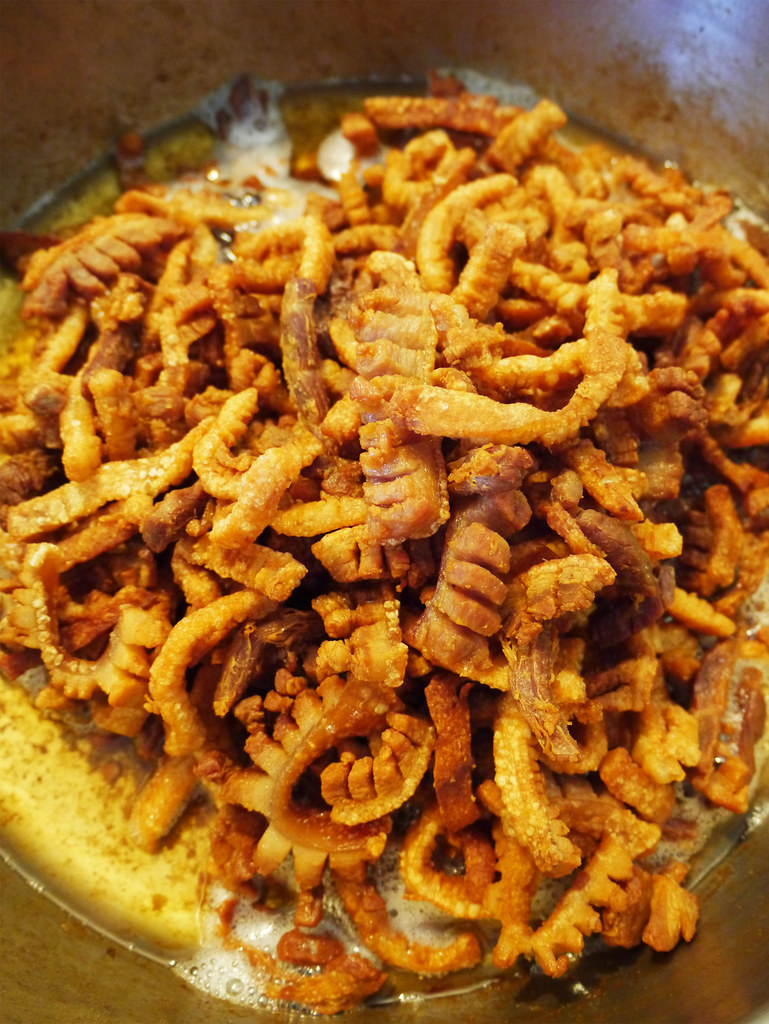
After about 20 mins of cooking and stirring (depending on how much crackling you’re making and how hot the heat is), the pork pieces will turn to a light golden colour and look crunchy and delicious! I prefer my pork crackling to still be a little soft and unctuous, and not too crunchy or crispy, so the ones in the photo above look just right to me. They look a little like caterpillars/grubs, don’t you think?
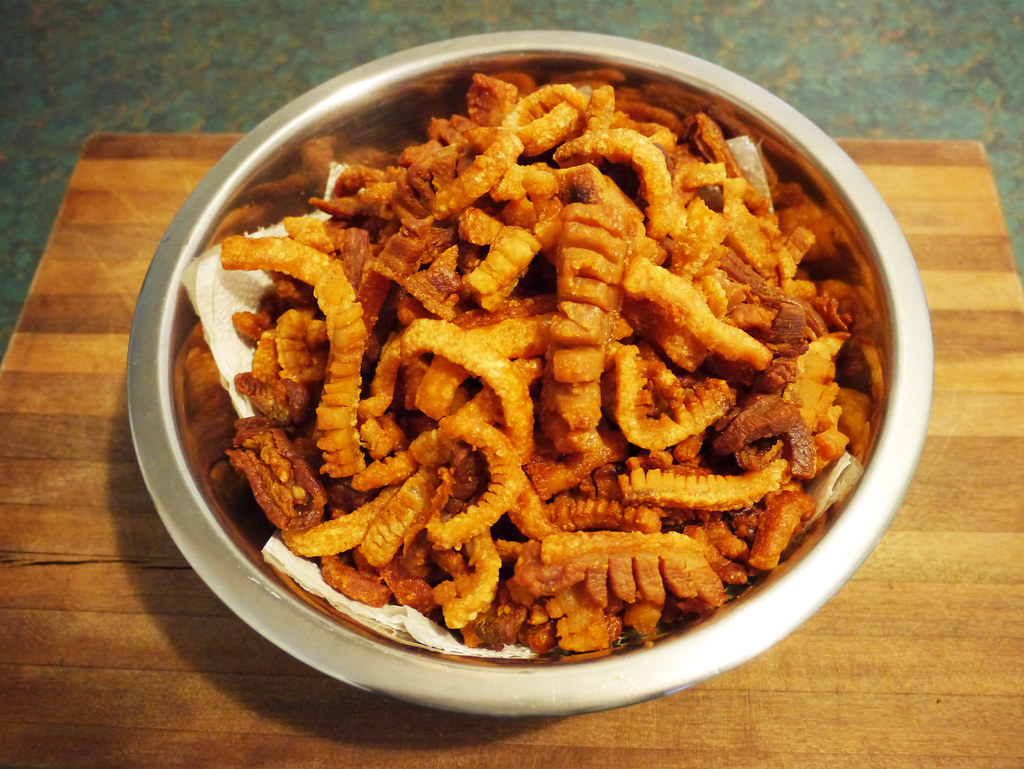
When they’re ready, turn off the heat, and strain the cooked pork crackling pieces from the oil to a bowl. Let the oil/lard cool down and then transfer it to a bowl or container and store it in the fridge for later use in your recipes, etc.
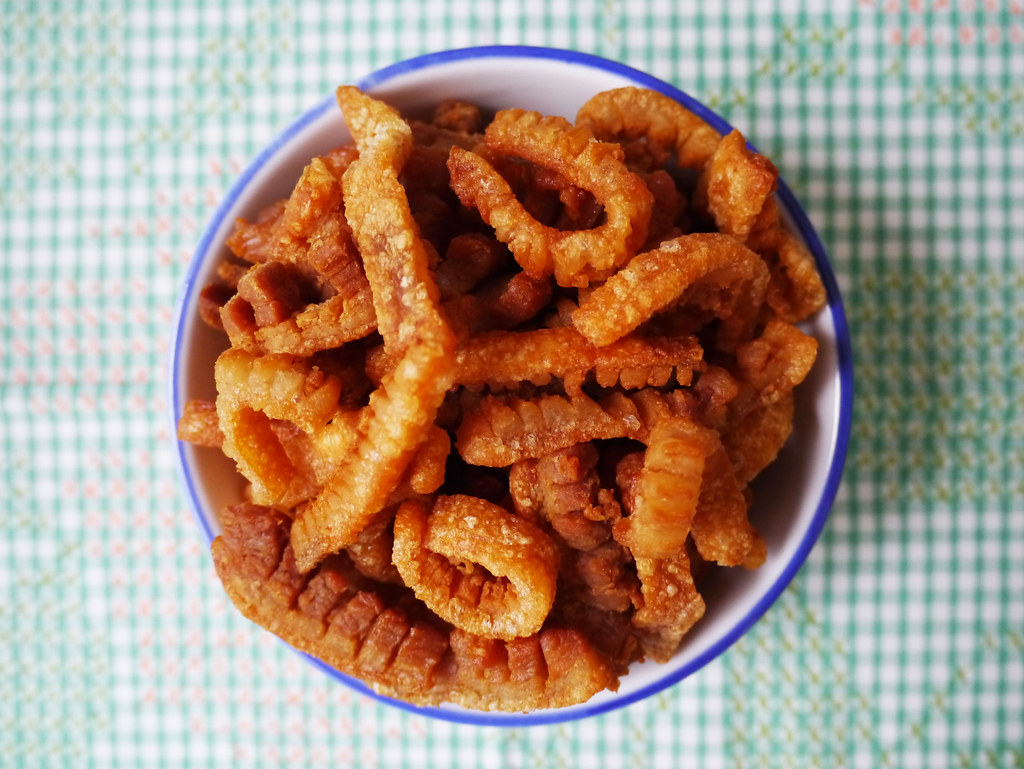
You can sprinkle the pork crackling with seasoning of your choice. Serve as a snack with your favourite drink or as an accompaniment with your meal. Enjoy sparingly. Bon appetit!
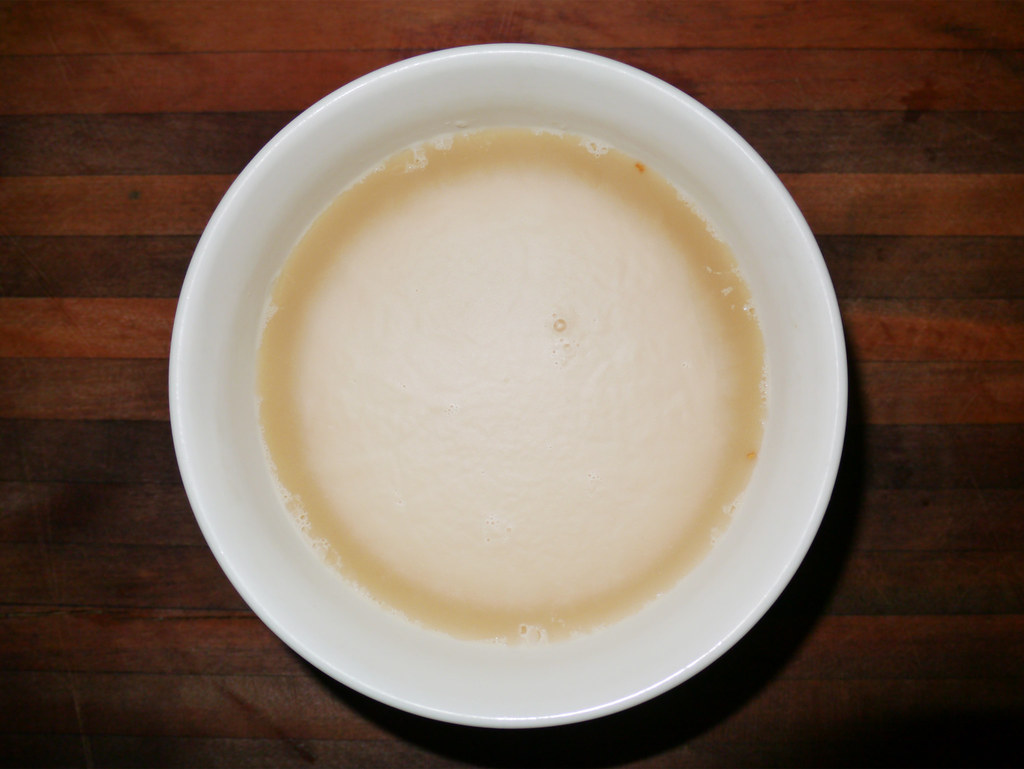
Pork lard – 3 hours later (with flash).
- Pork rind/skin (or pork belly or pork spareribs)
- 3 tablespoon of cooking oil
- salt
- With a sharp knife, cut the underside of the pork rind with long straight lines. Don't cut all the way through.
- Lightly sprinkle some salt to both sides of the pork rind and rub all over. Lightly sprinkle some salt to both sides of the pork rind and rub all over. Note: If you want your pork crackling and lard to remain saltless, you can skip this step. If you're using pork belly or pork spare ribs, remove the layer of meat from underneath the pork skin first, before cutting the underside of the skin/fat with a knife.
- With a sharp knife or kitchen scissors, cut the pork skin into small pieces/strips. Remember that once cooked, the pork skin/crackling will shrink in size and also possibly curl up if it is a long strip. I like to cut them into about 1 cm x 5 cm pieces, but it's really up to you how big and what shape you want your pork crackling to be. Note: If you're using pork belly or pork spare ribs, cut the fat and meat into small pieces as well. They also make delicious crunchy treats once cooked. Or, you can reserve them for another recipe.
- In a saucepan or wok, add the cooking oil and bring to low-medium heat.
- Add the sliced pork skin, fat and meat pieces and gently stir together.
- Continue to cook/fry the pork pieces and regularly stir. Be extra careful of the hot oil when stirring because it can pop and spit at you.
- When the pork pieces turn to a light brown colour, you can increase the heat to medium. This will cause the pork skin to blister and become more crunchy and crackly. Be careful to not overcook, and the oil will also get hotter and possibly pop and spit even more.
- After about 20 mins of cooking and stirring (depending on how much crackling you're making and how hot the heat is), the pork pieces will turn to a light golden colour and look crunchy and delicious!
- When they're ready, turn off the heat, and strain the cooked pork crackling pieces from the oil to a bowl. Let the oil/lard cool down and then transfer it to a bowl or container and store it in the fridge for later use in your recipes, etc.
- You can sprinkle the pork crackling with seasoning of your choice.
- Serve as a snack with your favourite drink or as an accompaniment with your meal. Enjoy sparingly. Bon appetit!
Did you know?
- Pork is the most widely eaten meat in the world accounting for over 36% of the world meat intake. It is followed by poultry and beef with about 33% and 24% respectively. 5
- Pigs are in fact very clean animals and even dung in a specific area of their pen. Pigs keep separate areas for sleeping, eating and dunging. When hot, they cover themselves in mud because they do not sweat. The mud works as a cooling mechanism. 6
Notes:
- Pork crackling and pork rind, as defined in this post refers to cooked (fried or roasted) pork skin, with or without some pork fat/meat attached to it. I personally like my pork crackling to have some fat and meat on it for the added texture, flavour and crunch. When making pork crackling, I like incorporate a mixture of plain pork skin, pork rind with some fat and meat on it, pork belly and other cuts of pork. The result is a wonderful medley of assorted pork crackling and “other” delectable pork bits and pieces. For this recipe, I’ve used the frying method to make the pork crackling (and lard). Alternatively, you can use the roasting method by simply placing the pork pieces in the oven. There’s much discussion on cooked pork rind/pork skin, including its definition, names and variations (for example, what part of the pork is used, how the pork skin is prepared/cooked, what seasoning is used, etc). The depth of this topic is beyond the scope of this post. For more info, go to: http://en.wikipedia.org. ↩
- Ready-made pork crackling is often available at many Asian grocery stores. Some snack companies, such as Nobbys also makes a variety of them. But believe me, if you enjoy the commercial pork crackling, you will LOVE the home-made ones even more! ↩
- For more info on pork lard, read this: http://en.wikipedia.org/wiki/Lard. ↩
- Crackling can also be made from other types of animal skin/fats, including pork ears, chicken skin, duck skin, fish skin, etc. I will endeavour to publish recipes on how to make these other types of crackling for you in the near future. Good excuse for me to make and eat more crackling really. ↩
- Source: FAO Trade and Markets Division, 2008. Reference: http://www.fao.org. ↩
- Reference: http://www.aussiepigfarmers.com.au. ↩